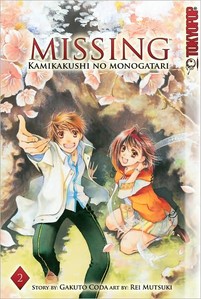Review
by Casey Brienza,Missing –Kamikakushi no Monogatari–
GN 2
| Synopsis: |  |
||
The four remaining members of the Literature Club split up into teams of two in order to pursue leads that they hope will help them find Kyoichi Utsume, otherwise known affectionately as “His Majesty.” Toshiya and Takemi seek out the school's resident “witch,” and she in turn sends them off to meet the most powerful magician she knows, Jinno. Jinno then explains to the two boys about the “other side” and how former humans like the kamikakushi Ayame are used as bait and gives them a mysterious bell that should assist them somehow in their quest. The two girls Aki and Ryoko, meanwhile, make an appointment at a Buddhist temple that specializes in exorcisms. The priest there eventually refers them to his twin brother, who gives them his version of an explanation of the beings who took Kyoichi and says that he has been fighting them in a secret war. |
|||
| Review: | |||
Although there is significant cross-pollination of properties across multiple media platforms, stories that work well in one medium do not necessarily work equally well for another. Take, for instance, feature films that get turned into videogames. The same long, cinematic sequences that wow moviegoers in theaters bore gamers looking for an intensively interactive experience. In the same way, some of the narrative devices that make novels gripping page-turners put manga on a fast-track to the recycle bin. Unfortunately, the second volume of Gakuto Coda's Missing –Kamikakushi no Monogatari– is one of those manga adaptations of novel series that would better serve its potential audience as toilet paper than as reading material. Although the first volume, with its mysterious plot setup, was passable in quality, volume two is, to put it as bluntly as possible, excretable. This is not the fault of Rei Mutsuki (also known as Lay Mutsuki, depending upon the romanization of her name), who adapted the novels. Mutsuki's layouts are decently attractive and cinematic in the standard fashion, and her fine-lined shoujo art is appealingly delicate and wispy. She even manages occasional moments of quirky cuteness, such as the snaggle-toothed Ryoko, that reminiscent of Karin and occasional moments of twisted, sinister expression reminiscent of D.Gray-man–although she is not able to sustain anything on even the mainstream, commercial level of Yuna Kagesaki or Katsura Hoshino for very long. Nor does the fault lie with the world-building or character-developing talents of Gakuto Coda. Despite the relatively large cast of characters for such a story series, they are all distinctive, with surprisingly complex personalities. In particular, both Aki, who it seems secretly has a crush on Utsume, and Utsume's childhood friend Toshiya have potential to impact the thrust of the narrative later on. Likewise, the relationship between the human world and that of the kamikakushi is reasonably nuanced and intriguing, with plenty of well-considered detail about how they entrap humans and try to integrate their world with ours. In this volume, for example, we learn that ghost stories are the keys with which these paranormal beings use to gain access to the human mind. After that, they can use those minds with psychic abilities to spread their influence further, like an infection. And once a human is drawn into their world, he is either destroyed or turned into a monster like Ayame, destined to bring doom down upon other humans. Clearly, this does not bode well for the Literature Club's chances of bringing back Utsume in one, sane piece. However, none of the art, characterization, or undergirding mythology locks together in this volume to make a remotely compelling whole. Instead, save a flashback in the beginning that explores Utsume's troubled childhood, all it does is delve into background. Deeply. Repetitively. One long, complicated exposition is bad form for the manga medium (“show, don't tell” definitely applies); two is bad for any medium. Yet two is exactly what is delivered here, since the characters split up into two groups and independently learn pretty much the same things about the kamikakushi from different groups of people one right after another. It's all so horribly unnecessary, and it is bad form that will leave you wishing you had not bothered in the first place. All in all, Missing –Kamikakushi no Monogatari– is actually worse than the sum of its parts, and that is an ignoble feat that happens only rarely. The pacing and action is grossly inappropriate, and at three volumes total, there is no room left for the sort of heroic redemption that is at this point required in the final chapters. Die-hard fans of the novel series might be interested in the manga, if only to see their favorite characters come to life and perhaps to enjoy the six-page bonus art gallery included at the end of this volume…but other potential readers would be well-advised not to bother. Do not let this pitiable excuse for printed matter spirit away your time and your hard-earned money! |
| Grade: | |||
|
Overall : C-
Story : C+
Art : B-
+ An intriguing premise and reasonably attractive artwork. |
|||
| discuss this in the forum (6 posts) | | |||
| Production Info: | ||
|
Full encyclopedia details about Release information about |
||